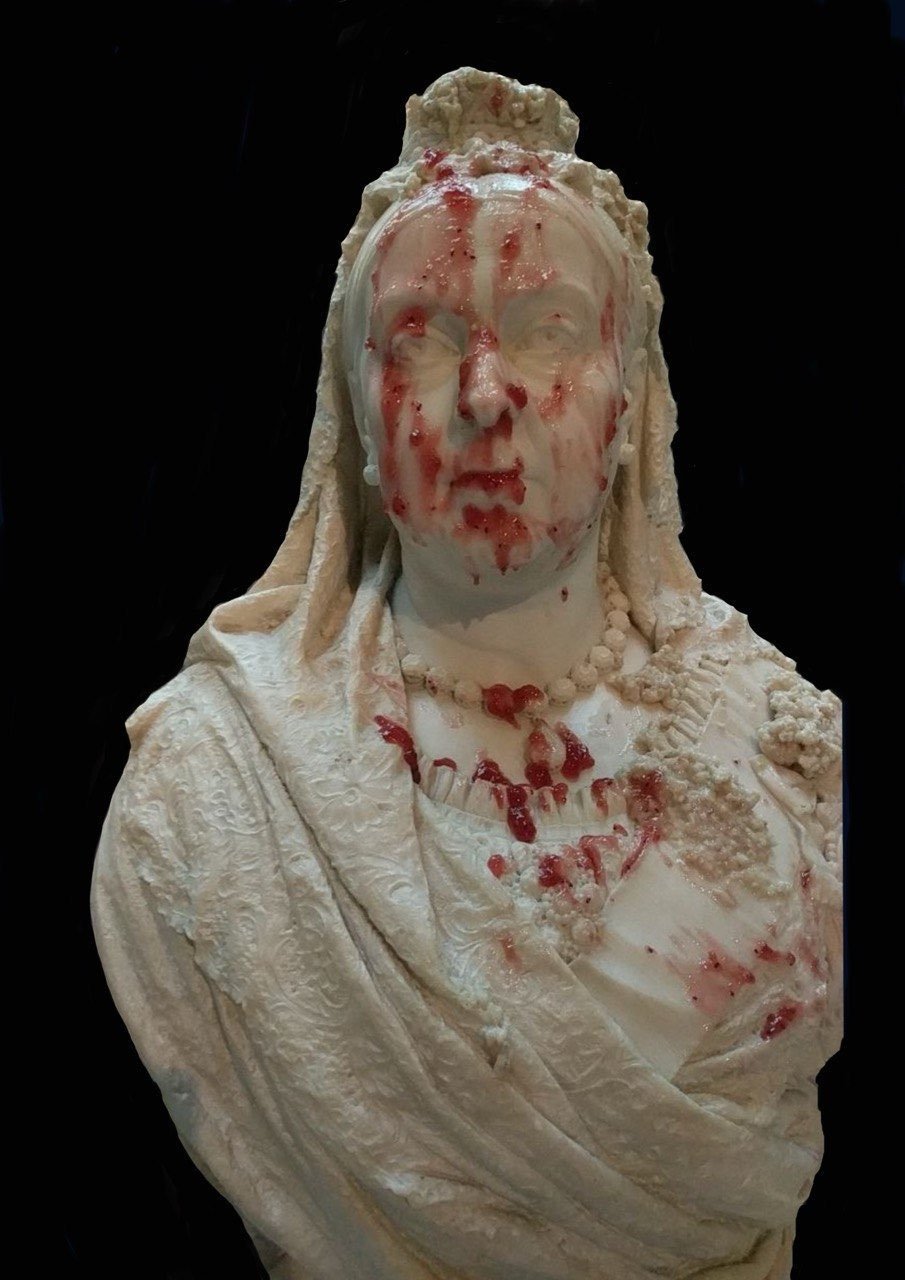‘Growing Pains for Museums’ On the destruction of art for activism
Co-curator, Sehar Mehmood, unpacks the complexities of working in the the museum sector, highlighting the political nature of the space, the challenges of representation, debates on activism and the need for museums to address social issues openly.
A bust of Queen Victoria in the Kelvingrove Museum was the subject of one such action.
By Sehar Mehmood | Photo by This is Rigged
I had barely dipped my toe into the complex waters of the museum industry when I watched the removal of the Edward Colston statue in Bristol by Black Lives Matter protestors. Its toppling, defacement and tossing into the river acted as my initiation into a sector whose legacy had promoted and championed the ideals of white supremacy. Some understand it as a form of co-curation, creating a new piece that drives forward a more contemporary and relevant narrative – a belief that ultimately led to the statue being exhibited in its defaced state.
The debate around the action highlighted the complicated reality of working in a space which many believed was politically neutral. Many of those who work in the sector, and the general public considered the museum space to be apolitical; a neutral zone in which history is told by an absolute and reliable authority.
I spent two years working as a community co-curator at Kelvingrove Museum and Art Gallery trying to understand what a decolonised museum could look like and how we could get there.
This task grew more complicated when I was working on the City of Empire exhibition at Kelvingrove Museum, which focuses on telling the true history of the British Empire, the transatlantic trade of Black people who were enslaved, and Scotland’s involvement. But what became clear was the fundamental fact that these ambitions could not begin materialising until the problem of the ‘neutral stance’ was addressed, and social issues openly spoken about.
Read more: City of Empire: Q&A with curators of a new exhibition unveiling Glasgow's colonial legacy
Museums have, for decades, operated as the consensus on knowledge, presenting to their audiences a manufactured image of a collective history that has excluded and whitewashed the stories of marginalised communities. But how can such institutions be neutral when sugar lords are remembered for their ‘great contributions to Glasgow’, as opposed to their complicity in the transatlantic trade of enslaved people? That is power, and power is political.
The City of Empire exhibition was an important step forward in recognising this. However, in my eyes, whatever progress that took place, took a hundred steps back the moment the museum chose to stay silent on Palestine.
It's a bitter and frustrating debate, made worse by a refusal to even show up in the room. But many in the museum sector are finding ways to show their solidarity, understanding that a neutral stance for museums doesn't exist – that the choice of silence isn’t staying out of politics, it's siding with the oppressor.
This raises a larger question on how social action taking place in museums is seen, by people inside and outside of the sector. The Edward Colston statue is only one example of a long legacy of art destruction in the name of a cause. However, the destruction of art for activism has also been labelled as ‘narcissistic’. Some have even called for protestors’ imprisonment. Others have asked, what it can possibly achieve – seeing only a nuisance and cleaning bill.
Read more: City of Empire: I See Your History
Closer to home, this debate flared when activist group This is Rigged walked into the Kelvingrove Museum and sprayed painted the word ‘c**t’ underneath the bust of Queen Victoria before pouring jam and porridge on her head and glueing themselves to the plinth. But this was just one step of their ongoing campaign to call attention to the cost of living crisis and climate emergency. They have also defaced government buildings, graffitied supermarket billboards and stolen baby formula to hand out on mother’s day.
These actions have unsurprisingly made many hysterical, with people not understanding what made this group so determined to bring focus to their cause. But This is Rigged has, since its inception, always been about people. Their soup nights, which form the core of the organisation, focus on community-centric action. Their ‘Robin Hood’ activities are about bringing attention back to the cost-of-living crisis.
Their ‘jamming’ of the Queen Victoria Bust at Kelvingrove was a statement of refusal to ‘be dragged back to the Victorian Era’ where ‘diseases such as rickets which once haunted Victorian slums are now on a sharp rise in Scotland.’ They claim the ‘crisis in public health [as] a direct result of our government’s chronic inaction on the crisis of food insecurity exacerbated by the climate collapse’.
The destruction of art for activism is a push for the realisation that silence isn’t good enough. It’s an act of resistance, as protesters urge people and institutions to act. So what if people think they're reckless or stupid? Because any chance to bring the cause into the conversation is at least making sure it's still on people's minds.
Without the tearing down of the Edward Colston statue, the opportunities to take on work in the museums sector which are centred around decolonisation and anti-racism may never have existed. Without their brief occupation of the museum space, and naming them complicit, the exhibit might never have been. As such, I see the destruction of art simply as growing pains for museums.
Throughout June, we are taking part in the 'No News is Bad News’ campaign – which is founded on the belief that a well-informed community is more able to act together to shape its own future, that local news is fundamental to a healthy democratic society and invaluable in helping to create strong communities. As part of this campaign, any money we raise for the project during June will be doubled by an Indie News Fund.
